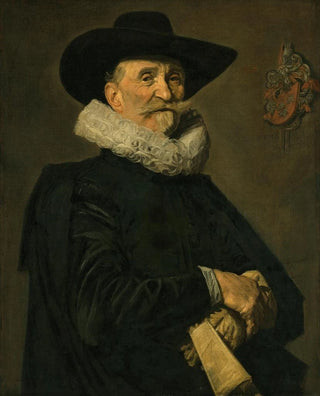Art print Portrait of a gentleman from the Wolff family, perhaps Joost de Wolff - Frans Hals | Reproduction


View from behind

Frame (optional)
Portrait of a gentleman from the Wolff family, perhaps Joost de Wolff - Frans Hals – Captivating Introduction
The "Portrait of a gentleman from the Wolff family, perhaps Joost de Wolff" by Frans Hals is an iconic work that embodies the very essence of Dutch Baroque portraiture. This painting, with its brilliance and vibrancy, transports us to a time when art and society were inextricably intertwined. Frans Hals, an undisputed master of portraiture, manages to capture not only the physical appearance of his subjects but also their personality, spirit, and social status. This painting, both intimate and majestic, invites us to explore the subtleties of a bygone era while celebrating the richness of Dutch artistic heritage.
Style and uniqueness of the work
The work stands out for its unique style, characterized by bold brushstrokes and masterful use of light. Hals excels in depicting textures, whether it be the sumptuous fabrics or facial details. The gentleman, whose identity remains partly mysterious, is portrayed with confidence that reflects his status. The nuances of color, ranging from deep blacks to golden highlights, create an atmosphere that is both dramatic and warm. This art print does not merely depict an individual; it tells a story, that of a man rooted in his time, while leaving room for the viewer's imagination. The way the gentleman's gaze seems to rest upon us establishes a direct, almost tangible, connection between the past and the present.
The artist and his influence
Frans Hals, born in Antwerp in 1582, is considered one of the greatest portraitists in art history. His thriving career in Haarlem allowed him to develop a distinctive style that influenced many artists after him. Unlike his contemporaries, who often favored rigid poses and fixed expressions, Hals infused unprecedented vitality into his portraits. He explored the psychology of his subjects, capturing moments of life and emotion with astonishing ease. His innovative approach paved the way for generations of artists, from Impressionists to Expressionists, who

Matte finish

View from behind

Frame (optional)
Portrait of a gentleman from the Wolff family, perhaps Joost de Wolff - Frans Hals – Captivating Introduction
The "Portrait of a gentleman from the Wolff family, perhaps Joost de Wolff" by Frans Hals is an iconic work that embodies the very essence of Dutch Baroque portraiture. This painting, with its brilliance and vibrancy, transports us to a time when art and society were inextricably intertwined. Frans Hals, an undisputed master of portraiture, manages to capture not only the physical appearance of his subjects but also their personality, spirit, and social status. This painting, both intimate and majestic, invites us to explore the subtleties of a bygone era while celebrating the richness of Dutch artistic heritage.
Style and uniqueness of the work
The work stands out for its unique style, characterized by bold brushstrokes and masterful use of light. Hals excels in depicting textures, whether it be the sumptuous fabrics or facial details. The gentleman, whose identity remains partly mysterious, is portrayed with confidence that reflects his status. The nuances of color, ranging from deep blacks to golden highlights, create an atmosphere that is both dramatic and warm. This art print does not merely depict an individual; it tells a story, that of a man rooted in his time, while leaving room for the viewer's imagination. The way the gentleman's gaze seems to rest upon us establishes a direct, almost tangible, connection between the past and the present.
The artist and his influence
Frans Hals, born in Antwerp in 1582, is considered one of the greatest portraitists in art history. His thriving career in Haarlem allowed him to develop a distinctive style that influenced many artists after him. Unlike his contemporaries, who often favored rigid poses and fixed expressions, Hals infused unprecedented vitality into his portraits. He explored the psychology of his subjects, capturing moments of life and emotion with astonishing ease. His innovative approach paved the way for generations of artists, from Impressionists to Expressionists, who
12,34 €






